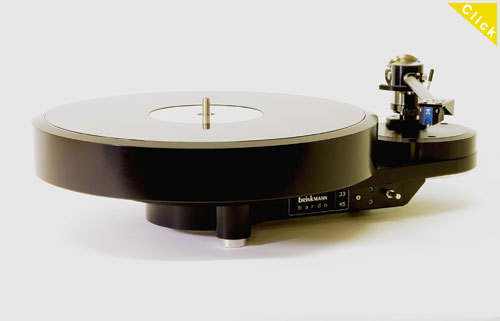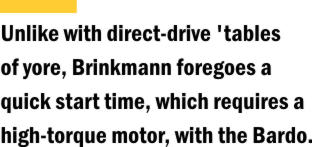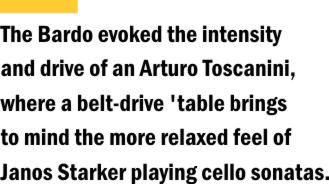Brinkmann Audio • Bardo Turntable
here are days when listening to music at home can be a Zen-like experience. Everything just falls into place and the music flows like a direct transmission from the gods. Most days, however, nirvana requires a little more help and a lot of attention to detail. Of all the components in an audio system, the turntable is unique in the amount of attention it requires. Routine use of even the simplest turntable requires constant effort -- from placing a record on the platter, to switching on power and cueing the tonearm. And then there is the smorgasbord of setup adjustments.
All this attention to handling translates to a significant amount of time spent closely inspecting the turntable, so that every nick and scratch becomes embedded in memory. Electronic-component settings, on the other hand, can usually be accomplished by remote control. With a turntable, putting your mind in remote control can be a recipe for disaster. Everything from leveling to tracking-force adjustment involves some degree of trial, error and risk of damage. If I were marooned on a desert island, I might have difficulty recalling the details of electronics I’ve owned for years, but I’m confident that I would have little problem recalling every detail of my turntable. Currently embedded in my memory are the sleek curves and beautiful lines of the Brinkmann Bardo, which recently spent time in my system alongside my longtime reference, the VPI TNT-6. Brinkmann has packaged the Bardo with its 9.6 tonearm and Pi cartridge ($3990 and $2690 on their own, respectively), creating a factory-assembled turntable system that makes the Bardo available at a lower price point than was possible with Brinkmann's 10.5 tonearm and EMT cartridge. The Bardo is the least expensive turntable in Brinkmann’s lineup. It has been available in the US for the last year. The 9.6 tonearm and Pi cartridge are new and first appeared in the US at the 2010 Rocky Mountain Audio Fest. After the show ended, the Bardo package used there made its way to my door. For those of you who haven’t studied your Tibetan Book of the Dead lately, "bardo" is a transitional state between death and rebirth. I’m not sure where Helmut Brinkmann was going with this choice of name, but I found nothing transitional about the Bardo. It's a finished product that I could see being many an audiophile’s last turntable. The Bardo borrows its direct-drive motor and platter from Brinkmann’s Oasis turntable and its spindle and bearing from the Balance. An outboard power supply is contained in a separate chassis and connected by umbilical to the 'table. The 'table sits on three precisely machined leveling feet. The plinth is manufactured of steel and aluminum. As far as I can tell, there is not a plastic part on the entire turntable. Here in the US, the Bardo package comes standard with a granite-slab base, but it can be ordered with a range of substitutes from Harmonic Resolution Systems (HRS). The review sample arrived with an HRS M3X platform, a $2100 option that improves upon the standard granite base by adding several resonance-control stages to further isolate the 'table from its environment. The platter comes standard with an integral acrylic mat. A glass platter mat and screw-down record clamp are offered as options for $1500. The platter mat covers the record-groove area, leaving an indentation for the label, which allows a perfectly flat record to lie flat without clamping. The platter has a recess around the spindle that accepts a removable spindle insert, included with the record-clamp option. This raises the label area and allows the clamp to leverage down the rim of the record more effectively. At the front of the plinth is a single switch with three positions: off, 33 and 45. There are two holes to reach speed-adjustment trim pots. The back of the plinth has RCA output jacks (XLR jacks can be ordered as an option), a receptacle for the power cord and a female jack for inserting a supplied ground line. In my system, I found the ground connection necessary. The Bardo caused an audible hum that completely disappeared with the 'table grounded to the phono stage.
The 9.6 'arm shares many component parts with the highly regarded (and more expensive) 10.5 tonearm, including the armtube with its hard ceramic surface, the headshell, the tonearm cueing mechanism and the mounting socket. It also appears to use the same magnetic anti-skating mechanism as the more expensive 'arm. The 9.6’s lower cost is achieved by substituting a unipivot design for the 10.5’s more expensive fixed-bearing assembly. VTA is set using a vertical screw adjustment and locked in with an SME-type locking screw. The Pi moving-coil cartridge was designed together with the 9.6 'arm, which should guarantee compatibility between the two, important with any 'arm/cartridge combination. It uses a microridge stylus mounted on a boron cantilever that drives a copper voice coil. It weighs 14 grams and has a specified output of 1.15mV. I found the Bardo to be the most attractive turntable in Brinkmann’s line -- and among today’s most attractive turntables, period. Your mileage will almost certainly vary, but for my money Brinkmann, Spiral Groove and TW-Acustic make some of the most beautiful pieces of audio jewelry you can buy right now. The Bardo costs $7990 standard -- $9490 with the mat/clamp upgrade -- so while it's not inexpensive, it bears one of the lowest price tags in this Museum of Modern Art competition. In addition to being drop-dead gorgeous, the Bardo is one of the best-behaved turntables I’ve used. I mean this as a compliment, not to suggest it is dull or predictable. The Bardo/9.6 combination does what it is supposed to do without complaint. I set up the 'table without need of the instructions, using them only to confirm what came intuitively. Confirmed with a KAB strobe disc, the two speeds locked in easily and stayed that way. The 9.6's cueing, height and anti-skate adjustments are simple to use, elegant and effective. While the headshell has no finger lift, the cueing mechanism is extremely accurate, so I didn't miss the finger lift. The 'arm descends at exactly the correct speed and it goes straight down, always placing the stylus exactly where I wanted it. While the Pi cartridge looks like it was born on the end of the headshell, it was the most finicky part of the package, requiring significant break-in. It also seemed a little more demanding than some cartridges -- requiring that the VTA be adjusted just so. Brinkmann recommends a load of 600 ohms; I set my Audio Research Reference Phono 2 for 500 ohms, the closest match available. evaluated the Bardo, 9.6 and Pi as a package instead of separately -- for several reasons. First, it was supplied this way, and Brinkmann offers it as a preassembled package for a reason. It allows buyers to acquire the 'table as part of an all-Brinkmann setup at a price that's significantly lower than with Brinkmann’s other tonearm and cartridge. Second, I’m a firm believer in maintaining consistency in approach, and where possible I like to match components as closely as possible. I use electronics and cabling from single manufacturers. Furthermore, attempting to compare each of the component parts of the Brinkmann package directly to other mix-and-match components would have been a nightmare with little reward. With four different parts (base, 'table, 'arm and cartridge) the combinations are endless. I first heard this system play at the Rocky Mountain Audio Fest, where it arrived in the middle of the last day of the show. I was surprised that distributor Philip O'Hanlon could get it up and running in so little time, let alone succeed in producing music. But upon setting it up for myself, I found out how much better it could sound with attention to small details. The cartridge had arrived from Germany without any break-in. Aligning it with a Feichert protractor, I found that it had to be positioned almost all the way forward on the headshell. Brinkmann recommends a tracking force between 1.8 and 2 grams, and I settled on the midpoint. One of the benefits of a direct-drive 'table is that wear and climate changes are not always affecting the alignment of the parts. Belts wear and stretch, and they react to temperature and humidity. Furthermore, if you touch them, oil transfers to the belt and modifies its grip on the platter. All of this means that with the Bardo, there was none of routine required with my rim-drive VPI, such as checking speed, which I did at least weekly. The Bardo avoids much of the need for tinkering made necessary when rubber meets the road. Speed never varied from day to day or week to week. Once leveled, the 'table never needed readjustment. Direct drive has it all over any belt- or rim-drive system for ease of use. But what about the sound? During their heydays in the 1970s and 1980s, direct-drive turntables had a well-deserved reputation for brittle sonics. I dipped my toes into the direct-drive pool during that time, only to retreat to the safety and more natural sound of a Linn Sondek. But that was decades ago. The best of modern direct-drive 'tables have overcome these shortcomings. Witness the recent success of the Grand Prix Audio Monaco, albeit at a significantly higher price point than the Brinkmann Bardo.
This more certain grip showed up differently, depending on the style of music. The Bardo's character was least apparent with vocal records. I’ve listened to Frank Sinatra’s voice on Nice 'N' Easy [Capitol Records/Mobile Fidelity MFSL 1-317] on countless systems, marveling at how different a simple selection can sound from one system to the next. While the differences between two turntables were not as stark as entire system changes, the Bardo did reflect a different flavor from belt drive. Sinatra’s voice sounded a bit more relaxed and more resonant with the VPI, while the Bardo made Frank sound a bit more driven and the backing orchestra a bit tighter. On a similarly simple assembly of instruments and voice, Louis Armstrong’s "St. James Infirmary" on Satchmo Plays King Oliver [Audio Fidelity AFSD 5930], the VPI setup seemed to slow down the pace of the music and string out the magic of this tune a bit more than the direct-drive 'table, which took a more headlong approach. The Bardo dispensed with some harmonic richness and substituted well-toned muscle in its place. On string music, the Bardo brought greater definition to the strings, capturing each centimeter of the bow’s vertical movement across the strings, as opposed to the sense with the VPI of more directly experiencing the strings’ horizontal vibrations as the bow moved over them. With large-scale orchestral works, the Bardo provided cleaner crescendos and a bit tighter bass, with various sections of the orchestra standing out -- and sorted out more distinctly -- compared to the VPI’s somewhat larger soundstage and more relaxed order of detail. The Bardo pulled more detail out of a complex mix of sounds -- things lost with the more tube-like sound of rubber-driven 'table. The Bardo’s mix of muscle and bass extension played well with rock and pop music too. The Bardo’s dead-on sense of pitch required a bit of adjustment to preconceived notions of what well-worn music was supposed to sound like. Can some of the size of the soundstage be a function of uncertain pitch? What of the greater sense of harmonics and the three-dimensional quality associated with the best belt-driven 'tables? Whether or not one course is more right than the other, there is no escaping the fact that the Bardo direct-drive route served up a very quiet background against which a tight and detailed yet non-fatiguing picture emerged. he Brinkmann package is an exceptional melding of beauty and smooth function. It delivered a balanced sound that I could easily live with, although some may prefer a more romantic mix of virtues. Its gorgeous styling, smart execution and muscular sonic delivery wrapped up beauty and the beast in a neat package. The Bardo may be dressed up with Brinkmann’s more expensive tonearm and cartridge stable-mates, not to mention additional power-supply and support-platform options, but I suspect the unit as packaged offers most of what can be obtained without losing sight of cost. The Bardo/9.6/Pi package offers a real taste of
direct-drive’s promise. You don’t get the advantages of a large 'table that can
accommodate multiple 'arms, nor can you adjust VTA on the fly. But if your goal is to
stick with one cartridge at a time and not incessantly adjust it, this combination’s
strengths of well-defined pitch, exceptional retrieval of detail, elegant controls and
gorgeous aesthetics may well be just the right mix for you.
|


 The Bardo’s magnetic
direct-drive system uses a motor designed and built in-house. The motor’s stator
consists of four field coils mounted concentrically around the platter bearing and opposed
to an eight-ring magnet. Unlike with direct-drive 'tables of yore, Brinkmann foregoes a
quick start time, which requires a high-torque motor, with the Bardo. It takes about 12
seconds for the Bardo to get up to speed, but after that much less energy is required to
maintain constant speed. Brinkmann claims this contributes to a silent drive and low
cogging effect. The 22-pound platter fits directly onto the motor assembly, which is built
into the chassis. Once the 'table is up to speed, the weight of the platter supplies most
of the rotational force, and the platter continues to spin long after the drive motor is
powered down.
The Bardo’s magnetic
direct-drive system uses a motor designed and built in-house. The motor’s stator
consists of four field coils mounted concentrically around the platter bearing and opposed
to an eight-ring magnet. Unlike with direct-drive 'tables of yore, Brinkmann foregoes a
quick start time, which requires a high-torque motor, with the Bardo. It takes about 12
seconds for the Bardo to get up to speed, but after that much less energy is required to
maintain constant speed. Brinkmann claims this contributes to a silent drive and low
cogging effect. The 22-pound platter fits directly onto the motor assembly, which is built
into the chassis. Once the 'table is up to speed, the weight of the platter supplies most
of the rotational force, and the platter continues to spin long after the drive motor is
powered down. Not surprisingly, the Bardo
does have a character much different from belt-drive 'tables. Once the cartridge broke in,
it was obvious just how much the Brinkmann approach differed from my experience with belt-
and rim-drive 'tables. The Bardo came across as a fast and muscular record-playing engine.
There was a sense of propulsion and accuracy. Perhaps some of this comes from the
Brinkmann’s Teutonic character, but I suspect that direct drive grips the road and
holds to the curves more precisely. The Bardo evoked the intensity and drive of an Arturo
Toscanini, where a belt-drive 'table brings to mind the more relaxed feel of Janos Starker
playing cello sonatas.
Not surprisingly, the Bardo
does have a character much different from belt-drive 'tables. Once the cartridge broke in,
it was obvious just how much the Brinkmann approach differed from my experience with belt-
and rim-drive 'tables. The Bardo came across as a fast and muscular record-playing engine.
There was a sense of propulsion and accuracy. Perhaps some of this comes from the
Brinkmann’s Teutonic character, but I suspect that direct drive grips the road and
holds to the curves more precisely. The Bardo evoked the intensity and drive of an Arturo
Toscanini, where a belt-drive 'table brings to mind the more relaxed feel of Janos Starker
playing cello sonatas.